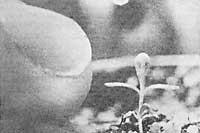Witness of live ice stations
Scientists from the Australian organization National Botanic Gardens grow a seed of a surprising eucalyptus. It may be the first seed of this species to be fertilized since the last ice age in Australia (10,000 years ago).
Last year was the only one that has germinated from a group of seeds of a new and surprising eucalyptus discovered in New South Wales. Only five specimens of these eucalyptus are known and five of them occupy an area of 100 m2.

The tree, with small, thick and fleshy leaves, is full of oil glands. Another 600 species of eucalyptus in Australia are very different and were considered in a family principle of guilt.
The territory in which the eucalyptus lives currently has a moderate climate. However, this eucalyptus presents some characteristics that relate it to the eucalites of cold weather.
The fertilization tests carried out also help this hypothesis, which is the case of eucalyptus, witness of the ice age. Traditional fertilization techniques failed. The only fertilized seed was produced when the seeds were stratified between layers of soil and introduced into a freezer. The need for cold to break sleep is not normal in Australian plants. Only people living in and around Australia need cold.
The need for cold has logically been an obstacle for the seed of this eucalyptus to fertilize naturally in the last 8,000 years, since the end of the ice age. Regional winters are not hard enough to break the seed's dream. On the other hand, the seeds retained in the soil are the food of the ants and, in addition, the dispersion of the seeds is a very surprising fact, since it only occurs after the fire.
We wish this newborn, witness of the ice, a long life.





